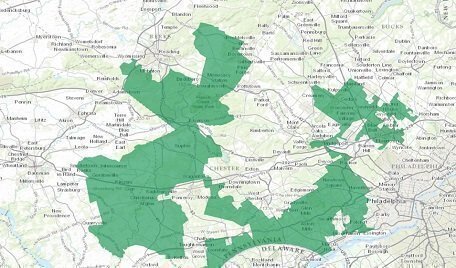In a ruling that potentially could be a political boon to Democrats running for Congress this year in Pennsylvania, a sharply divided state Supreme Court on Monday struck down 2011 maps for electing 18 members of the U.S. House of Representatives. Those maps have been used in elections since 2011, with Republican candidates winning 13 of the 18 seats, but with only a little more than half the votes statewide for House candidates.
 The ruling was based only on the state constitution, and that may insulate most of what the decision would do from being second-guessed by the U.S. Supreme Court.
The ruling was based only on the state constitution, and that may insulate most of what the decision would do from being second-guessed by the U.S. Supreme Court.
However, two Republican leaders in the state legislature said in a statement that they would ask the Justices in Washington, D.C., this week to block the ruling while they pursued a challenge. Maybe the only basis for a challenge would be a claim that the state’s highest court has no authority to draw the maps on its own – as the court said it would if the state legislature did not draw new and valid House districts on a very tight timetable.
The argument that the federal Constitution might bar a state court from taking on itself the task of drawing new congressional districts got some encouragement in a comment in one of the dissenting opinions filed in Monday’s decision.
Dissenting Justice Sally Updyke Mundy argued that it would raise “a serious federal constitutional concern” if the state court were to undertake itself the drawing of a new congressional districting map. She noted that the U.S. Constitution’s Article I assigns to state legislatures the task of defining the “times, places and manner” of holding congressional elections.
That appeared to be the provision on which the two state GOP leaders, Senate President Pro Tem Joe Scarnati and Senate Majority Leader Jake Corman, would rely in asking the U.S. Supreme Court to get involved.
Ordinarily, a state’s highest court has the final word on what the state constitution means, because the Supreme Court out of respect for state sovereignty will not disturb such decisions – unless they explicitly would violate a provision of the national Constitution or a provision of a federal law. For example, the Justices would not allow a state to interpret its constitution to exclude minority races from voting, because that would violate the Fifteenth Amendment as well as the 1965 federal Voting Rights Act.
As the federal Constitution is now understood – but this could change as a result of two cases the Justices are considering during their current term – the drawing of election districts to favor one political party’s candidates (“partisan gerrymandering”) is not unconstitutional.
That is why, for the time being at least, it is very significant when a state court interprets its own state constitution to outlaw such political favoritism, and that is exactly what the Pennsylvania Supreme Court’s new decision does explicitly.
Here, in summary, is the scope of that decision by the seven justices on that tribunal, with the majority not explaining the results but promising an opinion later:
First, by a vote of 5 to 2, it ruled that the 2011 map for redistricting the boundaries of the 18 House of Representatives seats “clearly, plainly and palpably” violates the state constitution. It did not say explicitly which provisions of that document had been violated, but the challengers had made only an argument that it was an invalid “partisan gerrymander.” Their argument relied upon four provisions of the Pennsylvania constitution – guarantees of free speech, free association, free and equal elections, and equality of legal protection. Justice Mundy, dissenting on that point, said in her dissent that the failure to cite the source of the violation would not give the legislature or the governor guidance on how to provide a remedy. She and Chief Justice Thomas G. Saylor would have found no violation, at least as the challenge now stands. Supporting the finding of a violation were Justices Max Baer, Christine Donohue, Kevin M. Dougherty, Debra McCloskey Todd and David N. Wecht.) The five-justice majority also laid down some principles that any new congressional map would have to meet, including placing as nearly as possible equal numbers of people in each of the 18 new districts.
Second, by a vote of 4-3, the court ruled that the 2011 congressional maps may not be used in this year’s elections to select the next occupants of the 18 seats, beginning with the scheduled May 15 primary.
Third, by that same vote, the court told the state legislature, if it wishes to draw new maps that would satisfy the state constitution, to submit them to the governor within 18 days – that is, by February 9, and told the governor if he accepted the legislative plan to submit it to the court by February 15 for its review.
Fourth, again by a 4-to-3 vote, the court said it would undertake to adopt its own plan if the legislature and governor had not come up with a satisfactory one. In anticipation of that possibility, it told the parties to submit their own maps to the court by February 15.
Fifth, by that same 4-to-3 vote, it ordered state officials to do everything they could to make sure that the May 18 primary goes ahead under a new plan.
On each of those 4-to-3 votes, Justices Donohue, Dougherty, Todd and Wecht were in the majority, and Justice Baer filed a partial dissent, objecting to the timetable the majority spelled out and arguing that new maps should only be made ready for the elections in 2020. Justice Mundy and Chief Justice Saylor applied their dissents to the timetable.
No part of the ruling, the court’s order said, would disturb a March 13 primary that is to be held in the 18th congressional district to fill a vacancy, using the 2011 map for that election only. (Justice Baer said that would add to the confusion, especially for voters in that district.)
If the state GOP leaders go ahead with their announced plan to ask the Supreme Court for a delay of the state court ruling, the first task for the Justices will be to decide if they have any authority to get involved in any way. How they vote on a postponement request might show where they stand on that constitutional question.






